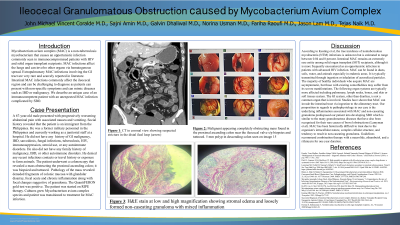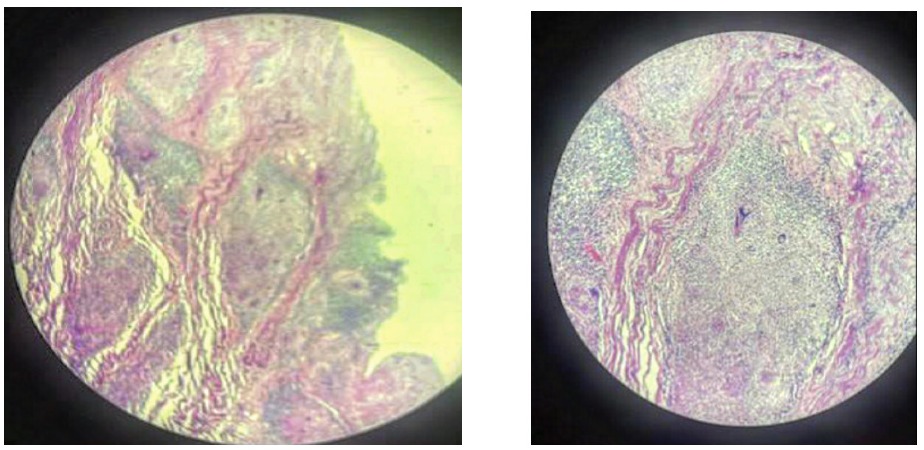Sunday Poster Session
Category: Small Intestine
P1564 - Constricting the Gut: Ileocecal Granulomatous Obstruction Induced by Mycobacterium avium Complex
Sunday, October 27, 2024
3:30 PM - 7:00 PM ET
Location: Exhibit Hall E

Has Audio
- SA
Sajni Amin, MD
Southwest Healthcare MEC
Temecula, CA
Presenting Author(s)
John Michael Vincent Coralde, MD1, Sajni Amin, MD2, Galvin Dhaliwal, MD3, Sukhman Dhaliwal, DO2, Sandesh Karki, MD2, Norina Usman, MD2, Fariha Raoufi, MD2, Tejas Naik, MD4
1Southwest Healthcare MEC, Murrieta, CA; 2Southwest Healthcare MEC, Temecula, CA; 3Southwest Gastroenterology, a Division of GI Partners of Illinois, Temecula, CA; 4Southwest Healthcare MEC, Corona, CA
Introduction: Mycobacterium avium complex (MAC) is a group of non-tuberculous mycobacteria that can cause opportunistic infections, primarily in individuals with compromised immune systems, such as those with HIV/AIDS or undergoing immunosuppressive therapy. While MAC infections commonly affect the lungs, they can also involve other organs, including the gastrointestinal (GI) tract, although such cases are rare and poorly documented. GI involvement typically presents with non-specific symptoms and can mimic other conditions like inflammatory bowel disease (IBD) or malignancy.
Case Description/Methods: 67-year-old male with a history of diabetes, hypertension, presents with progressively worsening abdominal pain. The patient denied any history of GI malignancy, IBD, sarcoidosis, fungal infections, tuberculosis, HIV, immunosuppression, steroid use, or any autoimmune disorders. Upon presentation, the patient's vitals were stable. CBC revealed leukocytosis of 19.89. CT abdomen revealed small bowel obstruction with suspected mass at the ileocecal valve. Colonoscopy revealed a mass obstruction at the ileocecal valve. Cultures were gathered during the resection of the lesion. Subsequent pathology results showed a non-caseating granuloma with a positive Quantiferon Gold test. Due to concern for latent tuberculosis, the patient was started on RIPE therapy. The final specimen culture grew MAC species. It was then that the patient was switched to antibiotic courses of ethambutol, azithromycin, and rifampin.
Discussion: MAC infections are uncommon in immunocompetent individuals, making this case particularly noteworthy. This case underscores the importance of a thorough approach in managing complex infections. The presence of mass at the ileocecal valve should invoke noninfectious and infectious differential diagnoses. A thorough history, physical examination, serological tests, imaging, and pathology reports can further narrow the diagnoses. According to Ra et al, a high background TB infection rate may pose a problem. Ra et al, indicated that a positive QuantiFERON-TB could not distinguish between active TB and MAC disease or latent TB infection in a TB endemic area. Thus, initial treatment could be RIPE therapy to cover active TB. Culture speciation and sensitivity of the specimen can ultimately guide antibiotic regimen. If culture grew MAC spp. the Infectious Diseases Society of America recommend a combination therapy with a macrolide, ethambutol, and a rifamycin.

Disclosures:
John Michael Vincent Coralde, MD1, Sajni Amin, MD2, Galvin Dhaliwal, MD3, Sukhman Dhaliwal, DO2, Sandesh Karki, MD2, Norina Usman, MD2, Fariha Raoufi, MD2, Tejas Naik, MD4. P1564 - Constricting the Gut: Ileocecal Granulomatous Obstruction Induced by <i>Mycobacterium avium</i> Complex, ACG 2024 Annual Scientific Meeting Abstracts. Philadelphia, PA: American College of Gastroenterology.
1Southwest Healthcare MEC, Murrieta, CA; 2Southwest Healthcare MEC, Temecula, CA; 3Southwest Gastroenterology, a Division of GI Partners of Illinois, Temecula, CA; 4Southwest Healthcare MEC, Corona, CA
Introduction: Mycobacterium avium complex (MAC) is a group of non-tuberculous mycobacteria that can cause opportunistic infections, primarily in individuals with compromised immune systems, such as those with HIV/AIDS or undergoing immunosuppressive therapy. While MAC infections commonly affect the lungs, they can also involve other organs, including the gastrointestinal (GI) tract, although such cases are rare and poorly documented. GI involvement typically presents with non-specific symptoms and can mimic other conditions like inflammatory bowel disease (IBD) or malignancy.
Case Description/Methods: 67-year-old male with a history of diabetes, hypertension, presents with progressively worsening abdominal pain. The patient denied any history of GI malignancy, IBD, sarcoidosis, fungal infections, tuberculosis, HIV, immunosuppression, steroid use, or any autoimmune disorders. Upon presentation, the patient's vitals were stable. CBC revealed leukocytosis of 19.89. CT abdomen revealed small bowel obstruction with suspected mass at the ileocecal valve. Colonoscopy revealed a mass obstruction at the ileocecal valve. Cultures were gathered during the resection of the lesion. Subsequent pathology results showed a non-caseating granuloma with a positive Quantiferon Gold test. Due to concern for latent tuberculosis, the patient was started on RIPE therapy. The final specimen culture grew MAC species. It was then that the patient was switched to antibiotic courses of ethambutol, azithromycin, and rifampin.
Discussion: MAC infections are uncommon in immunocompetent individuals, making this case particularly noteworthy. This case underscores the importance of a thorough approach in managing complex infections. The presence of mass at the ileocecal valve should invoke noninfectious and infectious differential diagnoses. A thorough history, physical examination, serological tests, imaging, and pathology reports can further narrow the diagnoses. According to Ra et al, a high background TB infection rate may pose a problem. Ra et al, indicated that a positive QuantiFERON-TB could not distinguish between active TB and MAC disease or latent TB infection in a TB endemic area. Thus, initial treatment could be RIPE therapy to cover active TB. Culture speciation and sensitivity of the specimen can ultimately guide antibiotic regimen. If culture grew MAC spp. the Infectious Diseases Society of America recommend a combination therapy with a macrolide, ethambutol, and a rifamycin.

Figure: Figure 1: Hematoxylin and eosin stain at low magnification showing stromal edema and loosely formed non caseating granuloma with mixed inflammation.
Disclosures:
John Michael Vincent Coralde indicated no relevant financial relationships.
Sajni Amin indicated no relevant financial relationships.
Galvin Dhaliwal indicated no relevant financial relationships.
Sukhman Dhaliwal indicated no relevant financial relationships.
Sandesh Karki indicated no relevant financial relationships.
Norina Usman indicated no relevant financial relationships.
Fariha Raoufi indicated no relevant financial relationships.
Tejas Naik indicated no relevant financial relationships.
John Michael Vincent Coralde, MD1, Sajni Amin, MD2, Galvin Dhaliwal, MD3, Sukhman Dhaliwal, DO2, Sandesh Karki, MD2, Norina Usman, MD2, Fariha Raoufi, MD2, Tejas Naik, MD4. P1564 - Constricting the Gut: Ileocecal Granulomatous Obstruction Induced by <i>Mycobacterium avium</i> Complex, ACG 2024 Annual Scientific Meeting Abstracts. Philadelphia, PA: American College of Gastroenterology.
